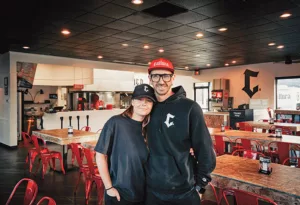
Take care of the caregiver
Prioritizing staff well-being is a pillar of patient care

Alex Barrouk is the founding director of Spokane-based Aim & Build Consulting & Development/Listen Louder. He can be reached at [email protected]; 310.980.0989.
Behind every successful patient interaction is a network of professionals whose sense of connection and care for each other quietly powers the entire health care system. If we want patients to feel safe, seen, and supported, then we must begin by focusing on the people who make that care possible.
Staff are your first clients. The way they are treated internally sets the tone for how they show up externally—for patients, for families, and for the organization as a whole.
The call for caregiver well-being is not just about morale. It’s a matter of organizational resilience and long-term strategic health.
What matters most for health care leaders is this: The emotional, spiritual, and psychological impact on caregivers has been profound and enduring.
Recovery in health care isn’t just clinical; it’s cultural. And rebuilding requires thoughtful, ongoing attention to the needs of those who bore the greatest burden.
Many caregivers are still navigating the aftershocks of the COVID-19 pandemic, including burnout, grief, and moral injury.
One nurse explains that there’s no time to stop and have a therapy session, but if they’re lucky, they can share a 15-minute break in the break room. But small moments can have a lasting impact on providers.
These micro-moments—often informal and unscheduled—are where resilience is built. Between shifts, during shared breaks, and through small rituals of connection, caregivers decompress and reconnect. They don't necessarily need formal support every time. Often, what sustains providers is simply feeling seen by someone who understands.
In leadership, recognizing and quietly protecting these moments can be just as important as launching new initiatives.
Danny Meyer, a leader in the hospitality industry, describes a “circle of enlightenment” in which an organization’s values radiate outward: first to employees, then to customers, and finally into the broader community.
Health care is no different. If we want compassionate, human-centered care to reach our patients, we must start by extending that care to our staff. Values don't flow outward unless they are lived inward. What we model inside becomes what we deliver outside.
Retention is rarely about a single factor. It's about the emotional experience of being part of a team—feeling trusted, supported, and inspired. While competitive compensation and career growth are critical, the day-to-day emotional landscape often determines whether someone stays or quietly begins to drift.
For example, another nurse explains that their reason for staying in the profession is how the people they work with make them feel. What binds teams isn’t just structure or schedules—it’s meaning. And meaning comes from connection.
There are resources available, as most health care systems offer employee assistance programs, mindfulness apps, or counseling sessions. And yet, these resources often go underutilized.
That’s not a sign of apathy; it’s a signal to explore why uptake is low. Barriers may include stigma, workload, cultural perceptions, or unclear communication.
Here’s how leadership can play a transformative role:
- Normalize the use of wellness resources in everyday dialogue.
- Integrate emotional check-ins into huddles or one-on-one meetings.
- Assign trusted team members as wellness liaisons or ambassadors.
- Model resource use by sharing personal or anonymized success stories.
The goal for leaders shouldn’t be to prescribe solutions, but to remove the quiet barriers that prevent people from saying yes to support.
Knowing when to step back as a leader is crucial. One of the most nuanced challenges in leadership is knowing when to hold space and when to allow space. Leadership should recognize that trust and connection flourishes best when nurtured, not micromanaged. As leaders, we’re often tempted to formalize what actually thrives informally. Sometimes, the most supportive thing leaders can do is create the conditions for connection—and then respectfully step aside.
Each caregiver brings a unique lens shaped by their background, identity, and life experience. Their needs won’t all look the same. And so, a single solution won’t fit all.
Supporting caregiver well-being means offering diverse options without needing to ask, such as peer-to-peer programs, anonymous or culturally sensitive support, opportunities for spiritual care or reflection, and simple spaces for rest and renewal.
It also means offering employees an opportunity to provide feedback by inviting staff to guide the evolution of wellness strategies over time. Inclusion isn’t just a value and should never be performative. Inclusion is a design principle.
If we want to care for caregivers, we must do more than appreciate them—we must support them through systems designed with intention.
Health care leaders should reframe caregiver wellness as an organizational strategy that makes well being a core metric of team health, not just a side benefit.
Before patients can feel well, health care providers must feel whole. Caregivers are more than workforce—they are the living fabric of care delivery. They are your reputation, your culture, your mission in motion. Taking care of them isn’t just compassionate. It’s strategic.
Alex Barrouk is the founding director of Spokane-based Aim & Build Consulting & Development/Listen Louder.
He can be reached at [email protected]; 310.980.0989.



_web.webp?t=1764835652)